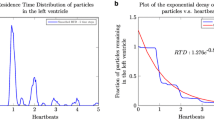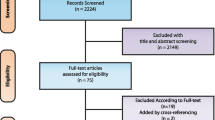Abstract
The gold-standard for pulmonary hypertension (PH) diagnosis is invasive right-heart catheterisation, a technique ill-suited for general patient screening. Noninvasive markers of PH are thus of direct clinical value. Using 4D Flow Magnetic Resonance Imaging (MRI), a recent empirical correlation has been observed between the duration of a blood vortex in the main pulmonary artery (MPA), and the mean pulmonary arterial pressure. The mechanism underlying this relationship, however, remains unknown. In this context, our aim was to replicate this correlation using computational fluid dynamics simulations. Retrospective MRI data from six subjects with suspected PH were used to generate patient-specific models of the pulmonary arteries. Vortex durations in the MPA were derived from the simulations using four methods: visual assessment, Q-criterion, Lambda2 criterion, and backward flow. Results were compared to reference durations predicted by the empirical correlation. The method most closely reproducing values from the relationship was the backward-flow approach (overall error of 7%, vs. 12–14% for the other methods). In-silico simulations are a valid approach to unveil the mechanistic factors driving pulmonary vortex behaviour in future larger modelling cohorts.
Access this chapter
Tax calculation will be finalised at checkout
Purchases are for personal use only
Similar content being viewed by others
References
Nakaya, T., et al.: Right ventriculo-pulmonary arterial uncoupling and poor outcomes in pulmonary arterial hypertension. Pulm. Circ. 10, 2045894020957223 (2020)
Vanderpool, R.R., et al.: Surfing the right ventricular pressure waveform: methods to assess global, systolic and diastolic RV function from a clinical right heart catheterization. Pulm. Circ. 10, 1–11 (2020)
Schäfer, M., et al.: Differences in pulmonary arterial flow hemodynamics between children and adults with pulmonary arterial hypertension as assessed by 4D-flow CMR studies. Am. J. Physiol.-Heart Circ. Physiol. 316(5), H1091–H1104 (2019)
Reiter, G., et al.: Magnetic resonance derived 3-dimensional blood flow patterns in the main pulmonary artery as a marker of pulmonary hypertension and a measure of elevated mean pulmonary arterial pressure. Circ. Cardiovasc. Imaging 1(1), 23–30 (2008)
Reiter, G., Reiter, U., Kovacs, G., Olschewski, H., Fuchsjäger, M.: Blood flow vortices along the main pulmonary artery measured with MR imaging for diagnosis of pulmonary hypertension. Radiology 275, 140849 (2014)
Kräuter, C., et al.: Automated vortical blood flow-based estimation of mean pulmonary arterial pressure from 4D flow MRI. Magn. Reson. Imaging 88, 132–141 (2022)
Kamada, H., Nakamura, M., Ota, H., Higuchi, S., Takase, K.: Blood flow analysis with computational fluid dynamics and 4D-flow MRI for vascular diseases. J. Cardiol. S0914–5087(22), 122–8 (2022)
3D Slicer. https://www.slicer.org/
Ansys. https://www.ansys.com/
Blanco, P.J., Feijóo, R.A.: A 3D–1D-0D computational model for the entire cardiovascular system. Mecánica Computacional 29(59), 5887–5911 (2010)
Ramos, J.G., et al.: Pulmonary hypertension by catheterization is more accurately detected by cardiovascular magnetic resonance 4D-flow than echocardiography. JACC Cardiovasc. Imaging 16(4), 558–559 (2023). https://doi.org/10.1016/j.jcmg.2022.09.006. https://www.jacc.org/doi/abs/10.1016/j.jcmg.2022.09.006
Kamada, H., et al.: Quantification of vortex flow in pulmonary arteries of patients with chronic thromboembolic pulmonary hypertension. Eur. J. Radiol. 148, 110142 (2022)
Hunt, J.C., Wray, A.A., Moin, P.: Eddies, streams, and convergence zones in turbulent flows. Studying turbulence using numerical simulation databases, 2. In: Proceedings of the 1988 Summer Program (1988)
Jeong, J., Hussain, F.: On the identification of a vortex. J. Fluid Mech. 285, 69–94 (1995)
Dong, Y., Yan, Y., Liu, C.: New visualization method for vortex structure in turbulence by lambda2 and vortex filaments. Appl. Math. Model. 40(1), 500–509 (2016)
Mawad, W., Fadnes, S., Løvstakken, L., Henry, M., Mertens, L., Nyrnes, S.A.: Pulmonary hypertension in children is associated with abnormal flow patterns in the main pulmonary artery as demonstrated by blood speckle tracking. CJC Pediatr. Congenit. Heart Disease 1 (2022)
Schäfer, M., et al.: Helicity and vorticity of pulmonary arterial flow in patients with pulmonary hypertension: quantitative analysis of flow formations. J. Am. Heart Assoc. 6(12), e007010 (2017)
Acknowledgements
We thank Daniel Giese at Siemens Healthcare GmbH, Erlangen, Germany, for providing the 4D flow work-in-progress package. Malak Sabry is supported by a PhD educational grant from Siemens Healthineers and the Magdi Yacoub Foundation.
Author information
Authors and Affiliations
Corresponding author
Editor information
Editors and Affiliations
Rights and permissions
Copyright information
© 2023 The Author(s), under exclusive license to Springer Nature Switzerland AG
About this paper
Cite this paper
Sabry, M. et al. (2023). Vortex Duration Time to Infer Pulmonary Hypertension: In-Silico Emulation and Dependence on Quantification Technique. In: Bernard, O., Clarysse, P., Duchateau, N., Ohayon, J., Viallon, M. (eds) Functional Imaging and Modeling of the Heart. FIMH 2023. Lecture Notes in Computer Science, vol 13958. Springer, Cham. https://doi.org/10.1007/978-3-031-35302-4_44
Download citation
DOI: https://doi.org/10.1007/978-3-031-35302-4_44
Published:
Publisher Name: Springer, Cham
Print ISBN: 978-3-031-35301-7
Online ISBN: 978-3-031-35302-4
eBook Packages: Computer ScienceComputer Science (R0)




